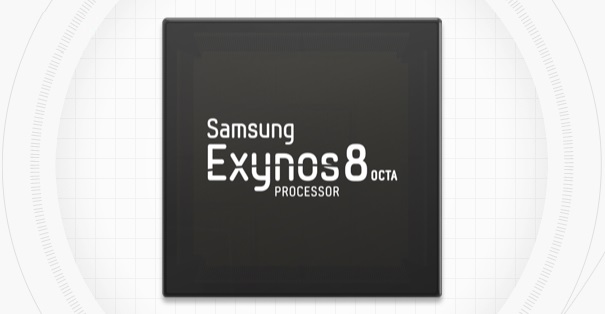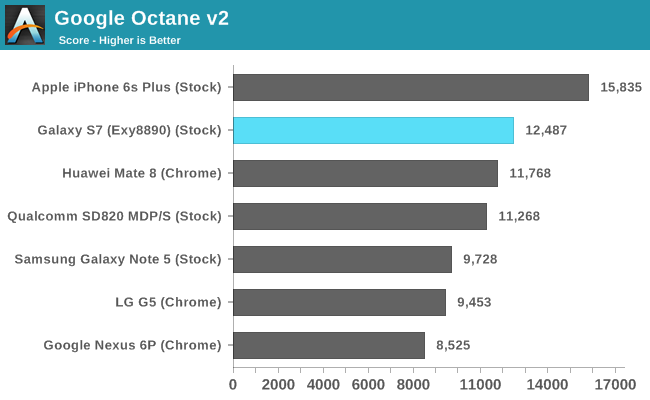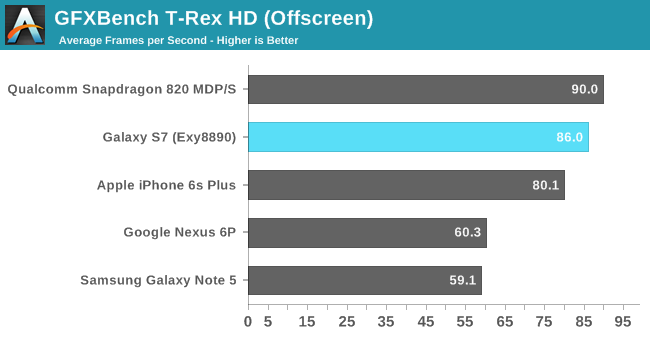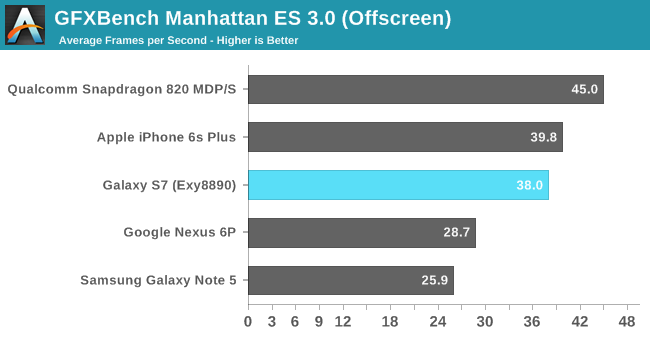Early Exynos 8890 Impressions And Full Specifications
by Andrei Frumusanu on February 21, 2016 6:15 PM EST- Posted in
- Smartphones
- Mobile
- SoCs
- Exynos 8890
- Exynos M1
- Samsung Galaxy S7

| High-End SoCs Specifications | |||
| SoC | Snapdragon 820 | Exynos 8890 | Exynos 7420 |
| CPU | 2x Kryo@1.593GHz 2x Kryo@2.150GHz |
4x A53@1.586GHz 4x Exynos M1 @ 2.60GHz (1-2 core load) 2.29GHz (3-4 core load) |
4x A53@1.50GHz 4x A57@2.1GHz |
| Memory Controller |
2x 32-bit LPDDR4 @ 1803MHz 28.8GB/s b/w |
2x 32-bit LPDDR4 @ 1794MHz 28.7GB/s b/w |
2x 32-bit LPDDR4 @ 1555MHz 24.8GB/s b/w |
| GPU | Adreno 530 @ 624MHz |
Mali T880MP12 @ 650MHz |
Mali T770MP8 @ 770MHz |
| Mfc. Process |
Samsung 14nm LPP |
Samsung 14nm LPP |
Samsung 14nm LPE |
The Exynos 8890 employs Samsung's own designed Exynos M1 cores. The micro-architecture at a high level resembles ARM's big cores, but Samsung seems to have made quite a few changes and improvements when compared to ARM's designs. While by now I do have a quite good idea of what the Exynos M1 looks like, we'll be covering the topic more in-depth in a future article once we'll be able to gain better insight from our own unit for proper benchmarking and power measurements.
On the CPU side we find an 8-core SoC composed of 4x Cortex A53 cores running at up to 1.586GHz coupled with 4x Exynos M1 cores in a big.LITTLE configuration. The most surprising revelation was the fact that the M1 cores reach an extremely high clock of up to 2.6GHz. This represents quite a significant boost over some past rumors which had put expectations 2.3-2.4GHz maximum frequency range. The catch here is that the Galaxy S7's power management doesn't allow all four cores to run at this high frequency but rather only enables the maximum clock when there's at most 2 cores loaded. If there are 3 or more cores under high load, the CPU frequency doesn't surpass 2288MHz.
On the GPU side we knew that we'd encounter a new ARM Mali T880MP12 - the currently largest Mali implementation available among existing SoCs. Back in November I theorized that Samsung would use the larger core implementation to lower the clocks of the GPU block and thus achieve better power efficiency. Indeed that's what seems to have happened as the Exynos 8890's GPU peaks at 650MHz versus the 770MHz frequency for the Exynos 7420. Hopefully this means that the new SoC will be able to maintain its peak performance for longer periods of time.


While I didn't have the time to run too many benchmarks, I did manage to run a few of our basic browser tests as well as GFXBench. We haven't had the opportunity to benchmark the Snapdragon 820 Galaxy S7 yet, therefore I included the score numbers of the MDP/S platform to represent a best-case scenario for the Snapdragon 820 until we can get apples-to-apples scores based on Samsung's browser. This still mostly due to the fact that Chrome is seemingly not yet optimized to take advantage of Kryo's new architecture, and as a result scores some rather mediocre numbers, as seen in some preliminary LG G5 numbers included in the graphs above.


Some quick GPU benchmarks also put the Exynos 8890 slightly behind the Snapdragon 820 in the MDP/S. We will still have to see if actual Snapdragon 820 devices are able to deliver the same performance as the MDP/S platform as there might be some thermal limitations coming into play. Again, we can't comment too much on the scores before we get to know each device's long-term performance and if the attained numbers are sustainable for long periods of time.
One observation I made today which was particularly concerning, was that both with the Snapdragon 820 LG G5 as well as the Exynos 8890 Galaxy S7 got considerably warm after running some heavy workloads. The fact that the Galaxy S7 touts having a heat-pipe thermal dissipation system is a quite worrying characteristic of the phone and should in no way be seen as a positive feature as it points to high power draw figures on the part of the SoC.
The first impression is that the performance difference between the Snapdragon 820 and the Exynos 8890 doesn't seem to be very large, therefore it will be the SoC's power draws and power efficiencies which will determine if, and which one of both will represent a superior design. Hopefully in the coming weeks and months we'll be able to get a better understanding of this new generation of SoCs so that we can paint a definitive picture of the current status of the mobile SoC space.










94 Comments
View All Comments
lilmoe - Monday, February 22, 2016 - link
"Sorry, but I write code"Any one can. Doesn't make you an expert in the subject at hand.
But I'm curious, do you write code for modern mobile apps?
ciderrules - Monday, February 22, 2016 - link
Sorry, no.The A9 absolutely TROUNCES the 7420 in single core and they are almost identical in multi core.
Considering the majority of software can't even utilize multiple cores effectively it's the single core tests that are the most important.
"Let the single-threaded argument go,. people" Spoken like someone trying to justify their mega-core device that doesn't even perform as good as a 2 core iPhone.
Toss3 - Monday, February 22, 2016 - link
Whatever happened to having a civil discussion on Anandtech? Of course a larger core is going to outperform smaller ones. I also don't know much about the software of iOS, but I assume it is a bit more efficient as well, which skews the performance numbers in the iPhone's favor. The A9 is a great chip, but pretty sure the s820 and Exynos 8890 have caught up to its performance numbers (the a9 is clocked much lower though). Remember that Apple is almost a year ahead of the rest when it comes to SoCs and phones; I see people comparing the S7 edge to the yet to be released iPhone 7, but it is meant to compete with the iPhone 6S, as those are the phones of the same generation.BurntMyBacon - Monday, February 22, 2016 - link
@Toss3: "Of course a larger core is going to outperform smaller ones. I also don't know much about the software of iOS, but I assume it is a bit more efficient as well, which skews the performance numbers in the iPhone's favor."Apple controls the hardware and software in the browser benchmarks. It is entirely plausible that they would gear their browser to take advantage of their heavy single threaded performance. In the end, this would help their end user experience as well, so I think we can take this as an assumed. Of course, that doesn't take away from the expectation that (assuming equally competent designers and process node) a larger core should outperform a smaller one in single threaded applications given its greater resources.
Others have said this, but it bears repeating. Huge differences in benchmarks can be seen on different platforms, browsers, or even configurations of the same browser. These differences exist for various reasons. To be sure, some are trying to game benchmarks. However, some are legitimately targeting a different aspect of the end user experience than the benchmark in question. Of course, some are just lazy or outdated. Conclusion, javascript benchmarks (or any benchmark that is extremely software/platform dependent) are a bad way to make conclusions about hardware as too many variables remain uncontrolled for proper testing. Now if you had the same OS, browser (including version), and configuration, there may be some merit as those variables are controlled. That simply isn't going to happen while Apple and Android make use of mutually exclusive hardware and operating systems.
lilo777 - Monday, February 22, 2016 - link
I do not quite understand why some people overemphasize the importance of single threaded performance when most of the tasks that really need the performance (gaming, image processing, compression, encryption etc.) are all perfectly multi-theadable. The trade off between having the highest performance when it does not matter (A9) vs having it when it actually matters (7420) seems to be pretty simple. Did you notice that Apple stopped using single/dual core CPUs on their laptops long ago. Why is that?mabellon - Tuesday, February 23, 2016 - link
Gaming has actually been notoriously bound by single threaded performance. That's part of why DX12/Metal/Vulkan is such a big thing. Reducing CPU costs and increasing parallelism to eliminate the current CPU bottleneck on the main render core. This is also going to be critical for VR where today single threaded performance is critical for render latency.Image processing is a good example of something that is too easily parallelized. It's best to use a GPU as a result for long running image manipulations. Compression and Encryption while potentially good choices, are best implemented by hardware offloads rather than a CPU.
No I did not notice Apple stopped using dual cores... because they didn't. The vast majority of what they sell is dual. The Macbook 12", MBA 11", MBA 13", Macbook Pro 13", entry level iMac, and every Mac Mini is a dual core. The only quad core laptop is the Macbook Pro 15".
Not only that but Apple makes the A9X in the iPad Pro. They could have easily made it a lower clocked quad core but instead made 2 high speed cores. They spent die space on cache and GPU rather than CPU cores. Because single threaded CPU performance really is that important.
Meteor2 - Monday, February 22, 2016 - link
Of course there is the question, how much performance is enough? I'm not seeing a great need for more performance outside of gaming.Dobson123 - Sunday, February 21, 2016 - link
The Galaxy S6 also got warm pretty quickly.lilmoe - Sunday, February 21, 2016 - link
Oh, I also wouldn't judge units on display if I were you.1) they've been kneaded like crazy from various people. who knows who did what.
2) That persistent, powerhog showroom/presentation software mode is on, which significantly slows down the device.
nerd1 - Sunday, February 21, 2016 - link
Comparing a production phone to the developer platform is a big joke..